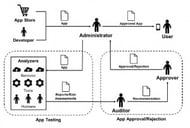Republished with permission from Apperian Blog
Written by James Seibel, Sr. Engineer in Apperian Labs
Mobile Device Management (“MDM”) is an infrastructure protocol for executing privileged commands on mobile devices. In other words, MDM is an infrastructure technology that enables administrators to take full advantage of features already included on devices. The MDM specifications are provided by operating system designers, for example Apple and Google, and include guides on how to implement them. It is crucial that enterprise app developers understand the differences in order to create secure and effective applications.

When it comes to the mobile device market, Apple continues to maintain an impressive lead in market share over Android devices with 42% of the U.S. smartphone market versus 26% for Samsung, according to market research from the NPD Group. The two giants are trailed by Motorola, LG, HTC and Blackberry, respectively. But when it comes to offering the most secure platform for developing enterprise apps, which operating system comes out on top – iOS or Android? Let’s compare.
The two operating platforms each have their own mobile device management (MDM) specifications. While the two approaches couldn’t be more different from one another, they are both important to take into account when developing enterprise apps – where security is often a client’s top priority.
For instance, the iOS MDM uses a single MDM administrator for each device while the Android MDM allows for multiple MDM apps per device. Meanwhile, for iOS devices, MDM commands are generated by the iOS operating system while MDM commands for Android devices are included in the Android library function and the determination as to when to execute those are carried out by programmers.
The key differences between the iOS and Android MDM strategies boil down to this: Apple defines and controls the MDM command list and sends out streams of MDM commands to all iOS devices (such as location tracking/Find My Phone to deleting App Store-installed apps from a device if a security flaw is detected). By comparison, the Android MDM command list is developed by different Android manufacturers (HTC, LG, Motorola, Samsung, etc.) with a smaller amount of MDM commands that cover security features….
Read the full post on App Developer Magazine!
Learn more about the benefits of using an enterprise app store and how Alpha Anywhere works with Apperian.
Written by James Seibel, Sr. Engineer in Apperian Labs
Mobile Device Management (“MDM”) is an infrastructure protocol for executing privileged commands on mobile devices. In other words, MDM is an infrastructure technology that enables administrators to take full advantage of features already included on devices. The MDM specifications are provided by operating system designers, for example Apple and Google, and include guides on how to implement them. It is crucial that enterprise app developers understand the differences in order to create secure and effective applications.

When it comes to the mobile device market, Apple continues to maintain an impressive lead in market share over Android devices with 42% of the U.S. smartphone market versus 26% for Samsung, according to market research from the NPD Group. The two giants are trailed by Motorola, LG, HTC and Blackberry, respectively. But when it comes to offering the most secure platform for developing enterprise apps, which operating system comes out on top – iOS or Android? Let’s compare.
The two operating platforms each have their own mobile device management (MDM) specifications. While the two approaches couldn’t be more different from one another, they are both important to take into account when developing enterprise apps – where security is often a client’s top priority.
For instance, the iOS MDM uses a single MDM administrator for each device while the Android MDM allows for multiple MDM apps per device. Meanwhile, for iOS devices, MDM commands are generated by the iOS operating system while MDM commands for Android devices are included in the Android library function and the determination as to when to execute those are carried out by programmers.
The key differences between the iOS and Android MDM strategies boil down to this: Apple defines and controls the MDM command list and sends out streams of MDM commands to all iOS devices (such as location tracking/Find My Phone to deleting App Store-installed apps from a device if a security flaw is detected). By comparison, the Android MDM command list is developed by different Android manufacturers (HTC, LG, Motorola, Samsung, etc.) with a smaller amount of MDM commands that cover security features….
Read the full post on App Developer Magazine!
Learn more about the benefits of using an enterprise app store and how Alpha Anywhere works with Apperian.







Comment